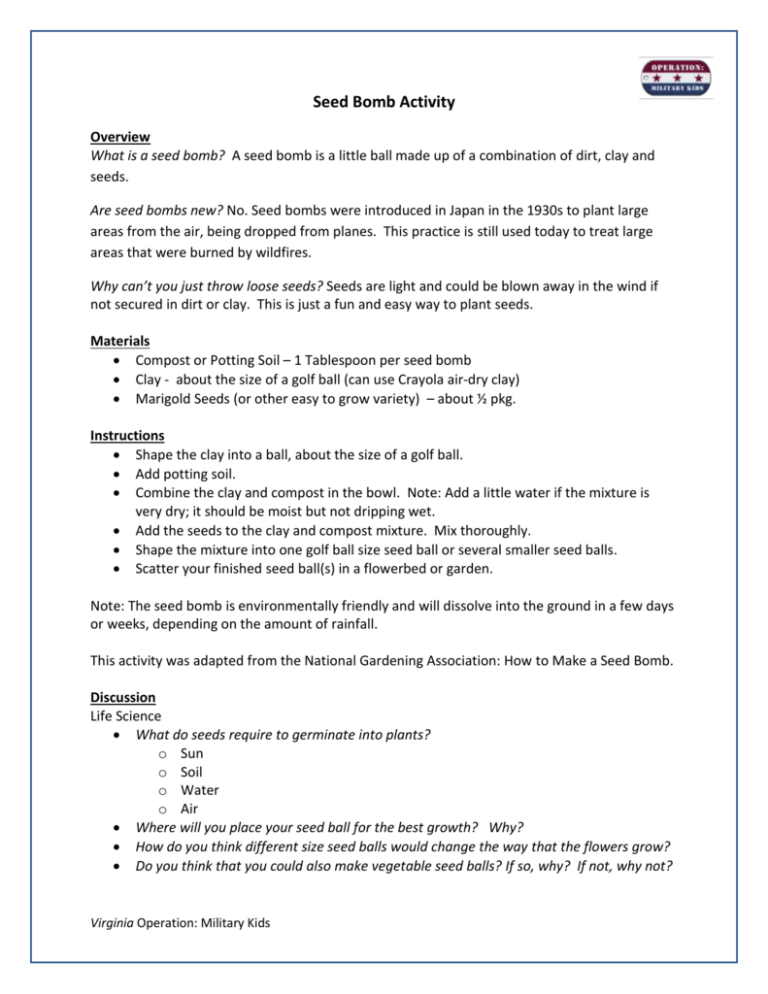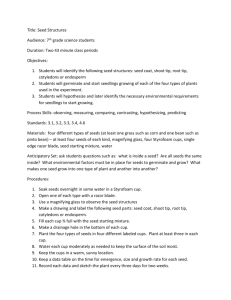Seed Bomb Activity - 4-H Military Partnerships
advertisement

Seed Bomb Activity Overview What is a seed bomb? A seed bomb is a little ball made up of a combination of dirt, clay and seeds. Are seed bombs new? No. Seed bombs were introduced in Japan in the 1930s to plant large areas from the air, being dropped from planes. This practice is still used today to treat large areas that were burned by wildfires. Why can’t you just throw loose seeds? Seeds are light and could be blown away in the wind if not secured in dirt or clay. This is just a fun and easy way to plant seeds. Materials Compost or Potting Soil – 1 Tablespoon per seed bomb Clay - about the size of a golf ball (can use Crayola air-dry clay) Marigold Seeds (or other easy to grow variety) – about ½ pkg. Instructions Shape the clay into a ball, about the size of a golf ball. Add potting soil. Combine the clay and compost in the bowl. Note: Add a little water if the mixture is very dry; it should be moist but not dripping wet. Add the seeds to the clay and compost mixture. Mix thoroughly. Shape the mixture into one golf ball size seed ball or several smaller seed balls. Scatter your finished seed ball(s) in a flowerbed or garden. Note: The seed bomb is environmentally friendly and will dissolve into the ground in a few days or weeks, depending on the amount of rainfall. This activity was adapted from the National Gardening Association: How to Make a Seed Bomb. Discussion Life Science What do seeds require to germinate into plants? o Sun o Soil o Water o Air Where will you place your seed ball for the best growth? Why? How do you think different size seed balls would change the way that the flowers grow? Do you think that you could also make vegetable seed balls? If so, why? If not, why not? Virginia Operation: Military Kids Food/Nutrition Are there any advantages to growing your own fruits and vegetables? o Health: Fresh fruits and vegetables can be free from pesticides. When picked and eaten when fully ripe, fruits and vegetables contain more nutrients. o Financial: Growing your own fruits and vegetables can save money. “An investment of $50 for seeds and fertilizer can produce $1,250 worth of groceries purchased at a supermarket.” (Burpee Seed Study) o Environmental: Growing your own food would reduce your environmental footprint by reducing the amount of trucks to take the fruits and vegetables to a grocery store. Fewer pesticides or natural pesticides would provide less environmental contamination. (eXtension) Physical Activity Does gardening help you to stay physically fit? o About 30 minutes of digging, pulling weeds, or removing rocks would burn an average of 200-250 calories (eXtension) Note: This activity is fun for all ages; the content can be adapted for the audience. Additional Resources National Gardening Association: How to Make a Seed Bomb (http://www.kidsgardening.org/sites/www.kidsgardening.org/files/Seed%20Bomb%20A ctivity.pdf) Instructables: How to Make a Seed Bomb (http://www.instructables.com/id/How-toMake-a-Seed-Bomb/) Virginia 4-H: Digging Down and Growing Up with Plants (http://www.uri.edu/cels/ceoc/documents/diggingDown.pdf) Burpee Seeds: http://www.burpee.com/gardening/pressrelease/families-can-cultivatefinancial-savings-with-burpee-s-money-garden-seed-pack/10011.html eXtension: Benefits of Growing Your Own Fruits and Vegetables (http://www.extension.org/pages/27731/benefits-of-growing-your-own-fruits-andvegetables#.U73WwzbD_IU) Virginia Operation: Military Kids







